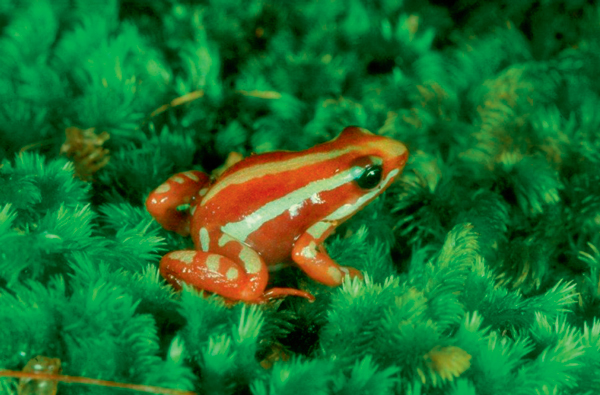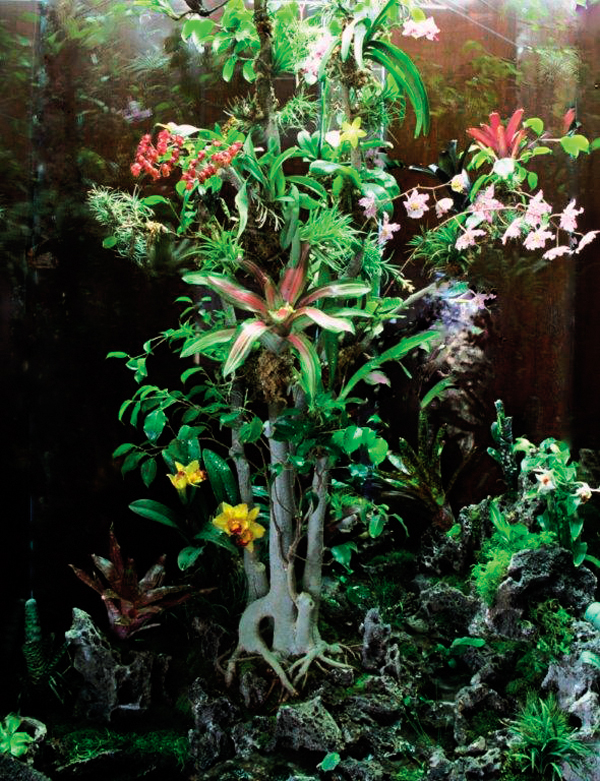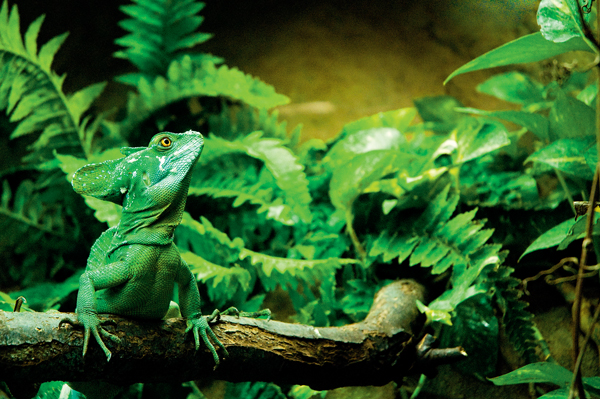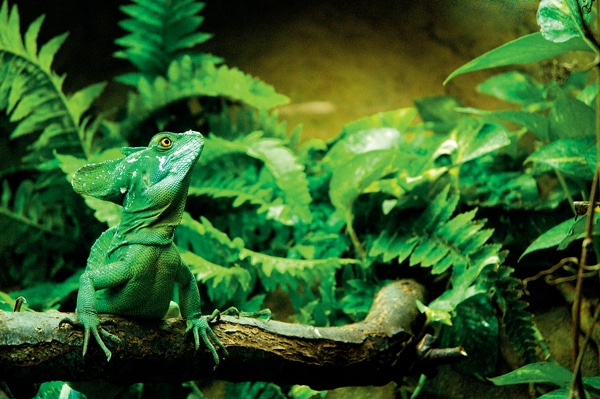Planting mix recipes to help you create amazing planted vivariums
As the popularity of natural planted vivaria continues to grow, and more people are considering trying one of these beautiful environments for their herps, it is beneficial to review some of the important factors for success.
One of the most important elements that is crucial for healthy, thriving, beautiful vivarium plants, as well as the health of vivarium animals, is the vivarium planting mix. Using an appropriate vivarium planting mix (usually called a “substrate” in the herp trade) is absolutely vital.
Two Areas of Concern
During my 30-plus years of creating natural vivaria and educating people about them, the two areas that have been most frustrating in terms of getting people to understand and proceed appropriately are lighting and planting mixes. Using the wrong kind and amount of light and/or the wrong planting medium is what leads to vivarium failure most of the time.

Rex Lee Searcy
This Anthony’s poison arrow frog (Epipedobates anthonyi) is sitting on a lush carpet of moss from the jungles of Asia, itself growing on a base of forest vivarium planting mix.
People seem to have a hard time believing that there is a real difference between an appropriate vivarium planting mix and regular potting mixes or various reptile bedding materials. I understand it is tempting to save money and time by just grabbing a bag of something at the local home improvement store, but most products that are not developed specifically for vivaria are problematic in some way and will usually lead, either immediately or over time, to the deterioration of your vivarium environment and the poor health, possibly even the demise, of your plants and animals.
Because the deterioration may be gradual and over the long term, it is often not recognized as the problem. People often blame their difficulties on some disease or other acute event that is, in fact, a symptom of the actual long-term cause.
Most potting mixes, and some bedding or substrate materials sold in the pet trade, contain elements that are directly harmful or will eventually be a problem in a vivarium environment. Some of these are harmful to the plants, but more of them are harmful to the animals, so beware. Some of these problematic elements include cedar, green tree moss, heavy metals, non-composted manure, peat moss, perlite, redwood, sludge, synthetic fertilizers, vermiculite and water-holding gels. I don’t have the space here to go into the specifics of why these components are undesirable, but have provided such information in past article—look for them in back issues of REPTILES, as well as on ReptilesMagazine.com.
The Good Stuff
In recent years, some good vivarium planting mixes have arrived onto the market. Look for those that use such components as ground coconut husk fiber (coir), chopped or cubed coconut husk, fir or aspen bark, true sphagnum moss (not peat or green tree moss), ground or chopped tree fern, and composted/organic plant and forest material. A few of these, developed and sold by specialty vivarium businesses online, are quite useful as is. However, in most cases, for optimal results it is necessary to mix them with other materials to get a planting mix that is catered to your individual needs.
To find prepared vivarium planting mixes, as well as other natural vivarium supplies and vivarium plants online, Google the following words/terms: vivarium planting mixes; vivarium substrates; vivarium supplies; vivarium plants; terrarium plants; greenhouse plants; tropical plants; fairy garden plants; miniature plants; dwarf plants; vivarium orchids; miniature bromeliads; tillandsias; dart frog plants; miniature cacti and succulents; aquarium plants; and tropical bog plants. You get the idea.

rex lee searcy
A bonsai-style weeping fig, with epiphytic orchids, bromeliads and other plants in this tall rain forest vivarium is growing in the basic forest vivarium planting mix.
It is very easy to make your own vivarium planting mixes using components that are readily available either online or from local stores. Following are a few recipes, with suggestions for substitutions and variations to meet your specific needs. These mixes simulate the uppermost layer (known as the horizon or topsoil) found in various kinds of natural environments, but are formulated to function appropriately in an enclosed vivarium. In a properly maintained vivarium, they should last at least several years before any refurbishing is needed. It is best to prepare these mixes several days to a week ahead of time, and to slightly moisten and allow them to rest in an open container before use.
Basic Bog Vivarium Planting Mix
Use this mix in bog or marsh vivaria (sometimes called “shoreline” vivaria). It is not an aquatic vivarium or aquarium mix, but should be used in areas that are completely saturated with water, for emergent bog plants, with up to an inch or so of water over the mix layer, but not in open-water areas. It provides a good anchoring medium for plant roots, holds nutrients, supports healthy biological activity and tends to stay in place better than simple aquarium sands.
2 parts natural sand, washed several times to remove the dust.
1 part ground coconut husk fiber
¼- to ½-part fully composted leaves
Quality commercial pond plant fertilizer formulated for use in fish ponds—use only a quarter of the amount per volume of mix recommended on the package
Microbial inoculant—commercial aquarium or pond inoculant, or bottom medium (about a handful of sand) from a healthy, established aquarium
Basic Desert Vivarium Planting Mix
Use this mix in desert and other arid environment vivaria. This is a relatively dense, high-mineral, low-organic content mix. It allows the top layer to dry out, forming a crust to facilitate stable burrows of lizards, etc., while retaining moisture and coolness in the deeper layers for plant roots and animal comfort in burrows.
2 parts natural sand
1 part ground coconut
husk fiber
½-part fully composted leaves
Organic, complete general purpose plant fertilizer, including trace minerals—use only one-third of the amount of fertilizer per volume of mix recommended on package
Sulfur (horticultural or garden, powdered)—1 teaspoon per gallon of finished substrate mix
Chunky Forest Vivarium Mix
Use this in specific areas of the vivarium where plants that require excellent drainage and lots of air around their roots are planted, such as some terrestrial bromeliads and orchids.
1 part basic forest vivarium planting mix (see opposite page)
2 extra parts bark/coconut husk cubes
Using Planting Mixes
Once your planting mix is prepared, pack it firmly into the base of your vivarium, so there will be little settling later. You can create natural-looking hills, slopes, valleys, etc., in your landscape.
Small, decorative rocks and wood can be placed on top of the mix, but large, heavy rocks that are major features of the landscape, rock waterfalls, rock caves or rocks under which animals may dig, should all be placed either directly on the tank bottom with the mix filled in around them, or supported on concrete blocks hidden in the mix under the rock. Otherwise, they will sink into the mix over time, ruining your landscape, damaging your plants and possibly crushing animals. All rock and other “hardscape” elements should be situated before you do any planting.
After preparing your plants by checking them for diseases/pests, rinsing them to remove any possible pesticide or fertilizer residues and removing as much of the old potting medium as possible without damaging the roots, you are ready to plant.

Michal Durinik/shutterstock
A plumed basilisk is a potential resident for a naturalistic forest vivarium.
Dig your plant hole where desired. Lower the roots into the plant hole, holding the plant in the position you want, with the base at the same level as it was in the pot. Fill in the mix around the roots, gently but firmly packing it snugly into place. If your planting mix has been properly moistened from the beginning, there is no need to water each individual plant at this point. Once all plants are in place, you can mist them for a few minutes. In the case of a desert vivarium, lightly sprinkle any newly added plants.
Planting Mix Components Defined and Described
Some of these components are familiar to people, while others are not so well known. Some are readily available commercially, while others are materials you must collect yourself. For example, partially composted leaves used to be commercially available at most nurseries, packaged and sold as “leaf mold”, but this is now difficult to find or unavailable in most areas. Use this information to make sure you are getting the correct components.
Leaves, Partially Composted
Partially composted leaves are important for contributing some of the starting population of natural beneficial bacteria and fungi. These will that create a biologically active mix that will break down and eliminate animals’ waste products to maintain a healthy environment. Partially composted leaves are also an important source of organic material and nutrients for plants.
They consist of the dead leaf litter around the base of tree and shrubs that is in various states of decomposition, from newly fallen surface material to the fine matter several inches down. The best types of leaves to use for this are small, relatively tough types such as live (scrub) oak, alder, elm, birch, aspen, poplar, beech, rose, etc. Avoid leaves that are too large, such as magnolia, sycamore, etc., or which are delicate and turn mushy too quickly, like maple. Also avoid leaves that may be significantly toxic, such as oleander, in vivaria that may house herbivorous herps.
Do not collect leaves from areas that may have been exposed to insecticides or herbicides. To eliminate any possible unwanted bugs and most weed seeds, spread leaves out on a tarp or blanket in a dry area for two or three days. Bugs will leave, dry up or get eaten by birds.
Leaves, Fully Composted
Same as described previously for partially composted leaves, except with the freshly fallen leaves and larger pieces removed. Fully composted leaves are the very fine, dark and crumbly leaf material from the lower layers of leaf litter.
Orchid/Reptile/Fir/Aspen Bark or Wood Chips
Bark/wood chips are important for creating texture, friability, aeration, drainage and longevity of the mix. Make sure the product is fir or aspen—most packaged and marketed for reptile or orchid use are these types. Do not use bark or wood chips of redwood, cedar, pine or cypress, which contain various resins, oils, phenols, tannins, acids and other toxic compounds that are dangerous to herps and plants.
Bark/wood chips come in several sizes or grades, typically small, medium and large. The medium grade is best for most vivarium uses. These are widely available in reptile/pet stores, home improvement stores, online herp/vivarium suppliers, etc.
Coconut Husk Fiber (aka Coir)
Coconut coir is a by-product of the coconut industry that is now being extensively used as a planting/bedding material for plants and herps. It is a superior replacement for peat moss.
Coconut coir comes in bags or compressed blocks. Soak it and squeeze it out several times before use to remove any possible excess salts from processing, and to create a moist, fluffy material. Widely available in reptile/pet stores, home improvement stores, online herp/vivarium suppliers, etc.
Coconut Husk Cubes/Chips
These are the same material as the coconut coir described above, only chopped into pieces about ½ to ¾ inches in size. They are basically interchangeable with the bark products described previously, and are possibly longer-lasting in the mix, which increases the effective life of the mix. They are available online from horticultural suppliers, and even on Amazon or ebay.
Natural Sand
Natural sand is usually derived from degraded, or ground, rock and is composed of a variety of particle sizes, with both very fine material (clay) and larger grains up to the size of a small pea. It may seem “dirty” to you. This is good. Some commercial sands that usually qualify would include decomposed granite (DG) and other crushed rock sands, such as crushed sandstone. The best place to look for these sands is at rock supply companies. Most carry DG and other natural sands. Sandy soils collected from unpolluted desert or arid areas will work, but not dirt from your yard. Some home improvement warehouses also carry DG.
Avoid aquarium sand, play sand (used for sandboxes, etc.), or silica sand. You don’t want anything with uniform grains or only larger grains. Don’t use sand or rocks from the beach, as they may contain excessive amounts of salts that will harm your plants and animals.
Fertilizer, Natural or Organic, Complete General Purpose
Use a good all-purpose fertilizer with trace minerals. Most fertilizer packages have three large numbers on the label that indicate the percentages of the three major components: nitrogen, phosphate and potash. These numbers should be about equal or with slight variation (e.g., 10-10-10 or 12-5-7, etc.).
The most common and important trace minerals that should be included are boron, copper, iron, manganese, molybdenum and zinc. All of this information, called a guaranteed analysis, should be listed somewhere on the package.
Avoid fertilizers with large or colorful particles, as some lizards may eat some of the pieces, leading to impactions.
Fertilizer, Pond
Use a quality commercial pond plant fertilizer formulated for use in fish ponds. These are available from pond, koi or water lily suppliers and some home improvement centers or nurseries.
Sulfur
Powdered sulfur is available at most nurseries and home improvement warehouses. It may be packaged as a soil acidifier or “bluing formula” for hydrangeas and other acid-loving plants.
Most of the natural sands used to create the desert vivarium substrate mix are alkaline to some degree, so sulfur is used sparingly to buffer, or balance out, the mix, making it more neutral. Neither the fertilizer described above nor sulfur will harm your animals in any way when used as directed here.
Microbial Inoculants
These are products that contain various compositions of bacteria and fungi (microryza). These are used to create base populations of beneficial microfauna in soil or water to improve the health of the soil or water and assist plants in nutrient acquisition and growth. This will get your vivarium planting mix functional and effective right away.
A natural vivarium with carefully selected plants, a proper vivarium planting mix, proper lighting and other appropriate environmental systems is truly a lovely thing to behold, and the healthiest, most stimulating environment for your animals. A little research, effort and some well-spent funds will reward you with a perfectly functional ecosystem that will serve you and your animals for years. REPTILES
Rex Lee SEARCEY is a writer and environmental designer. Through his business, Secret Environments, he designs and installs specialty environments for private homes and businesses. Vivaria are his specialty, and he also designs terraria, aquaria, custom dog runs, cat porches, chicken environments, indoor/outdoor water features, planters and other naturalistic environments.


